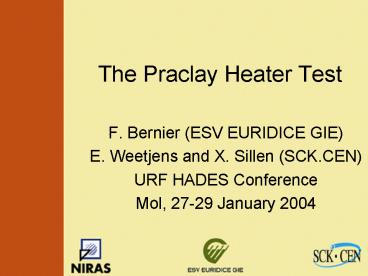The Praclay Heater Test - PowerPoint PPT Presentation
1 / 19
Title:
The Praclay Heater Test
Description:
... a conservative way the most critical state and phenomena that could ... A characterisation programme of each part of the system. Modelling. Instrumentation ... – PowerPoint PPT presentation
Number of Views:66
Avg rating:3.0/5.0
Title: The Praclay Heater Test
1
The Praclay Heater Test
- F. Bernier (ESV EURIDICE GIE)
- E. Weetjens and X. Sillen (SCK.CEN)
- URF HADES Conference
- Mol, 27-29 January 2004
2
The EBS architecture for disposal of cat. C waste
has been reviewed
- Three alternatives are considered
- Supercontainer (SC)
- Borehole
- Sleeve
- Choices has to be kept as flexible as possible to
get the possibility to reorient parts of the
design towards another alternative at minimal
cost
3
Consequences on thePRACLAY experiment
- Experience as initially planned specific to one
detailed design will not be possible - PRACLAY has to be
- Addressed to the three alternatives
- Enlarged to characterisation, verification,
confirmation and demonstration
4
The PRACLAY testspreliminary design
Heated part 30m
1m
10m
2 m
- Heater Test
- THM/C at large scale
- H. Plug Test
- Disposal gallery cut-off
- Installation
- Performance
- Backfill Test
- Fabrication
- Installation
- Performance
- ESDRED - EC
Crossing Test - EDZ - no starting chamber
5
Main objectives of the heater test
- Configuration similar to a real repository
- Combined effect of the EDZ and the TDZ
- Effect of the thermal load on the stability of
the lining (retrievability) - Verification and confirmation of our knowledge of
the THM/C behaviour of Boom Clay - Demonstration that the thermal load does not
affect the performance of the Boom Clay layer
6
The test has some limitation
- Short heating period (10 years) compared with a
real repository - Different boundary conditons
- Different heat source
- No radioactive source
- ..
- The aim of the test is to reproduce in a
conservative way the most critical state and
phenomena that could occur in the host rock
7
Why a large scale heater?
- Boom Clay is considered as the main barrier
- Confidence building
- Confirmation that BC behaves as predicted
- Milestone for the disposal strategy
- The thermal load is the most severe transient
that the repository system will undergo on a
large spatial scale and in a relatively short
period of time - Results will not be affected with local
heterogeneities
8
Case study showing the large scale impact of the
thermal load(Picard Giraud 1995)
200 m
Initial thermal flux 1W/m³
10 m
9
(No Transcript)
10
Experience from small-scale heater tests
- CACTUS, CERBERUS, BACCHUS, ATLAS
- The THM behaviour is quite consistent
- ? T ? ? p, ?
- dissipation of p and ? but ? in a smaller
proportion - ? permeability and water content
- ? density
- consolidation
11
The large scale heater test will be
representative for all the designs
3D - Borehole design
2D SC and sleeve design
2 canisters per 5 m (201 W/m)
200 m
100 m
T in function of the distance from the source?
1 m
20 m
20 m
12
For X gt 2m the influence of the design on T is
very limited
13
Optimisation of the heat source
- Accurate time-dependant heat output of HLW
- will increase excessively the period of the test
- The objective is to heat a large volume of clay
within a period of 10 years to be representative
in terms of maximal temperature and thermal
gradient
14
Constant flux (290W/m ___ ) or Constant
temperature (90C - - -)?
T016C
15
30 m is considered for the length of the heat
source
16
Isotherms around the heaterare representative in
the central part
17
The heater test will be accompanied with
- A characterisation programme of each part of the
system - Modelling
- Instrumentation
- from the connecting gallery
- radially to the PRACLAY gallery
- temperature, displacements, pore water and total
pressure, fracturation, water sampling (chemical
analysis)
18
Planing
- General design 2004
- Characterisation programme 2005
- Construction of the PRACLAY gallery and
installation of tests 2006 - Start of the heat phase 2007
- Preliminary conclusions 2012
- Start of the cooling phase 2017
19
Conclusions
- The large scale thermal behaviour is a remaining
key issue - Most severe impact that the repository will
undergo - The whole thickness of Boom Clay will be affected
- Milestone for the disposal strategy
- Confidence building
- Open to international cooperation
- Design not yet fixed































